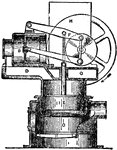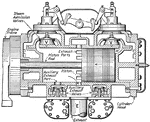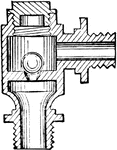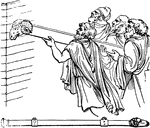
Battering Ram
"The battering ram was a large beam, made of the trunk of a tree, and having a mass of bronze or iron…
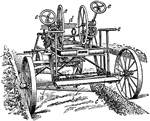
Road Machine
"Road-machine. a, telescopic axle for rear wheels; b, scraper delivering spoil between rear wheels;…
Steam Engine Valve with Lap Connected to Rocker
"This occurs in horizontal engines when the valve is set on top of the cylinder instead of on one side.…
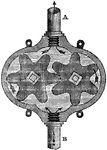
Rotary Pump
"The design is to produce a continued stream, by simply turning it into a crank, thus converting the…
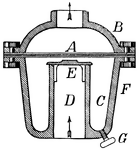
Sand Trap
Part of a hydraulic engine. "A device for separating sand and other heavy particles from running water.…
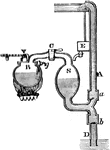
Savery Engine
"Savery's Steam Engine. The adjoining figure illustrates the apparatus employed by Savory. It consists…

Valve with Lap of Steam Engine at Extreme Left with Exhaust Ports Open
"Since the valve must move a distance equal to the outside lap before admission can take place, it is…

Spark Plug
This is a spark plug which fits into the cylinder head of some internal combustion engine and ignites…

Engine Starter
Starter motor also starting motor, or starter is an electric motor that rotates an internal combustion…
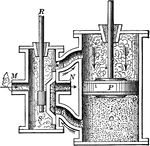
Steam Engine
"The steam engine is a powerful device for utilizing the energy involved in the elasticity and expansive…
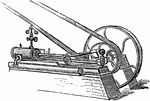
Steam Engine
A steam engine is a heat engine that performs mechanical work using steam as its working fluid. Steam…
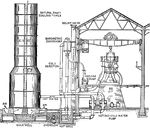
Steam Engine
Cross-section of a steam engine plant with Alberger barometric condenser and cooling tower.

Steam Engine Valve with Lap Steam Where Slide Valve is Closed
"The relative positions of crank, eccentric and valve when the exhaust closes on the crank end and compression…

Steam Engine Valve with Lap Where Steam is Admitted to the Slide Valve
"While the crank is moving from the position, steam is being admitted to the head end and being exhausted…

Steam Engine Valve with Lap Steam Where Slide Valve is in Open Position
An illustration of the valve with lap at the end of the crank end steam compression. The piston will…

Steam Engine Valve with Lap Steam Where Slide Valve Moved to Open Position
"If the inside lap is increased, the valve must move farther before released occurs and the crank angle…

Hero's Steam Engine
"High volumes of steam were pumped into the hollow sphere. The steam would then escape through the many…

Steam Engine Rocker Arrangement with Valve and Reverse Rod in Eccentric Motion
"This arrangement makes it possible to place the valve and steam chest above the valve motion. A rod…
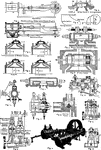
Steam engines
"The steam engine, in its many forms, is the agent by means of which part of th eenrgy stored up in…

Mobile tower
"They who are within this machine obtain first a view of the place from their high position, and then,…
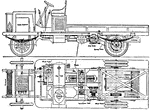
Steam Operated Tractor with Outside Spring Suspension
A tractor compound steam engine with outside suspension spring. The spring suspension helps stabilize…

9000 Kilowatts Vertical Curtis Turbine
An illustration of 9000 kilowatts capacity vertical Curtis turbine. Each turbines are located between…
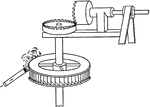
Branca's Impulse Steam Turbine
"In 1629, Branca, an Italian, invented a turbine much like a miniature water wheel, which was driven…

Westinghouse Parsons Turbine Viewed Cross Sectionally
A cross sectional view of Westinghouse Parsons turbine. Steam enters at V and exits at E, turning the…

Early Parsons Steam Turbine
"In 1885, Parsons took out his first turbine patent on a motor along the lines previously suggested…

Hartman's Compound Impulse Turbine
"In 1858, Hartman Bros. patented a turbine consisting of two revolving disks c and c' fixed to a shaft…
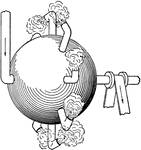
Hero's Simple Steam Turbine
A simple steam turbine by Hero of Alexandra during first century AD. The turbine consists of a hollow…

Sectional View of Kerr Turbine
"The shaft, where it passes through the diaphragm, is fitted to a bronze bushing with a few thousandths…
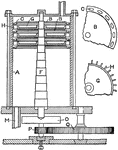
Real and Pichon Compound Steam Turbine
"A compound turbine was patented by Real and Pichon, the idea being to reduce the velocity of rotating…
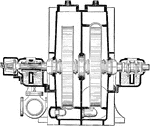
Cross Sectional View of Two Stage Condensing Terry Steam Engine Turbine
A two stage condensing Terry turbine from a steam engine. The steam, entering from the top, rotates…

Wilson's Compound Steam Turbine
"A view of Wilson's invention is shown; a, b, and c, are vance which are attached to and rotate with…
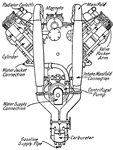
V Type Motor, with Eight Cylinders
This illustration shows a V type motor with eight cylinders, fans, and many other parts: Gasoline Supply…

Valve with Lap of Steam Engine Where Steam Enters the Slide Valve Compartment
"The maximum displacement of the valve is attained when the eccentric is horizontal. In this position…

Slide Valve of Steam Engine
"The amount that the valve overlaps the steam ports is called the lap of the valve. It will at once…
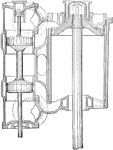
Cross Sectional View of the High Pressure Cylinder of Piston Valve from USS Massachusetts
"This valve consists of two pistons connected by a sleeve through which the valve rod passes. This valve…

Motored Vehicle
A motor vehicle is a wheeled vehicle whose propulsion is provided by an engine or motor. The internal…
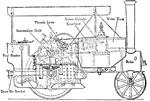
Side and Inside View of Steam Operated Vehicle
A side and inside view of the superheated steam vehicle. Water is heated by a heat transferred by the…
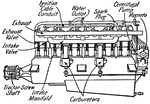
Vertical Type Motor, Six Cylinder
This illustration shows a six cylinder motor and its many parts: Intake Manifold, Centrifugal Pump,…

Two Vessels from Thomas Savery First Steam Engine
Two vessels from the Thomas Savery first steam engine. The right tank fills up with water while the…

Steam Wagon with Two Side Chains Transmitting Drive
An illustration of a steam wagon with a transmission with two side chains. The boiler is located on…

Steam Wagon with Single Chain Transmitting Drive
A steam wagon with single chain, connecting the back wheels to the differential gear. The engine is…

Wagon with Steam Engine and Transmission Gearing with Double Helical Gear
"The transmission on the first type of vehicle is by means of gearing throughout, and is completely…

Steam Operated Wagon with Transmission Gearing with Double Helical Gear
A steam operated wagon with two speed gear. The gears are located at the intermediate shaft, moving…

Yorkshire Steam Wagon Patent
A Yorkshire steam wagon patent with unique boiler construction. The wagon operates with the drive chain…

Water Jet Deflected 90 Degrees Measuring Force
"If the velocity of impact of the jet is V feet per second, its velocity in the same direction after…


